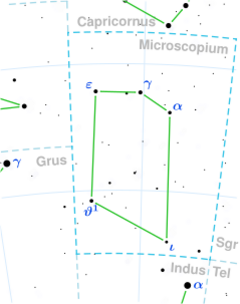Astronomy:HD 196737
| Observation data Epoch J2000.0 Equinox (celestial coordinates) | |
|---|---|
| Constellation | Microscopium |
| Right ascension | 20h 40m 19.82792s[1] |
| Declination | −33° 25′ 54.6462″[1] |
| Apparent magnitude (V) | 5.47±0.01[2] |
| Characteristics | |
| Evolutionary stage | red giant branch[3] |
| Spectral type | K1 III[4] |
| U−B color index | +1.08[5] |
| B−V color index | +1.12[5] |
| Astrometry | |
| Radial velocity (Rv) | 14.2±2.8[6] km/s |
| Proper motion (μ) | RA: +21.953[1] mas/yr Dec.: +34.487[1] mas/yr |
| Parallax (π) | 13.5581 ± 0.0691[1] mas |
| Distance | 241 ± 1 ly (73.8 ± 0.4 pc) |
| Absolute magnitude (MV) | +1.17[7] |
| Details | |
| Mass | 1.4±0.1[8] M☉ |
| Radius | 11.5[9] R☉ |
| Luminosity | 43.7+3.1−2.9[10] L☉ |
| Surface gravity (log g) | 2.46±0.34[11] cgs |
| Temperature | 4,681±122[12] K |
| Metallicity [Fe/H] | −0.02[13] dex |
| Rotational velocity (v sin i) | <1[14] km/s |
| Age | 3.4±0.6[8] Gyr |
| Other designations | |
| Database references | |
| SIMBAD | data |
HD 196737, also designated as HR 7893, is a solitary orange hued star[16] located in the southern constellation Microscopium. It has an apparent magnitude of 5.47,[2] allowing it to be faintly visible to the naked eye. The object is located relatively close at a distance of 241 light years based on Gaia DR3 parallax measurements,[1] but is receding with a heliocentric radial velocity of 14.2 km/s.[6] At its current distance, HD 196737's brightness is diminished by 0.14 magnitudes due to interstellar dust.[17] It has an absolute magnitude of 1.17.[7]
This is an evolved giant star with a stellar classification of K1 III.[4] HD 196737 is estimated to be 3.4 billion years old based on asteroseismologic measurements,[8]enough for it to cool and expand onto the red giant branch; it is now fusing a hydrogen shell around an inert helium core.[3] It has 1.4 time the mass of the Sun[8] and an enlarged radius of 11.5 R☉.[9] It radiates 43.7 times the luminosity of the Sun[10] from its photosphere at an effective temperature of 4,681 K.[12] HD 196737 has a solar metallicity — what astronomers dub chemical elements heavier than helium. The star has a projected rotational velocity too low to be measured accurately.[14]
References
- ↑ 1.0 1.1 1.2 1.3 1.4 Vallenari, A. et al. (2022). "Gaia Data Release 3. Summary of the content and survey properties". Astronomy & Astrophysics. doi:10.1051/0004-6361/202243940 Gaia DR3 record for this source at VizieR.
- ↑ 2.0 2.1 Høg, E.; Fabricius, C.; Makarov, V. V.; Urban, S.; Corbin, T.; Wycoff, G.; Bastian, U.; Schwekendiek, P. et al. (March 2000). "The Tycho-2 catalogue of the 2.5 million brightest stars". Astronomy and Astrophysics 355: L27–L30. ISSN 0004-6361. Bibcode: 2000A&A...355L..27H.
- ↑ 3.0 3.1 Jones, M. I.; Jenkins, J. S.; Rojo, P.; Melo, C. H. F. (December 2011). "Study of the impact of the post-MS evolution of the host star on the orbits of close-in planets: I. Sample definition and physical properties⋆⋆⋆". Astronomy & Astrophysics 536: A71. doi:10.1051/0004-6361/201117887. ISSN 0004-6361. Bibcode: 2011A&A...536A..71J.
- ↑ 4.0 4.1 Houk, N. (1982). Michigan Catalogue of Two-dimensional Spectral Types for the HD stars. Volume III: Declinations −40° to −26°. Bibcode: 1982mcts.book.....H.
- ↑ 5.0 5.1 Oja, T. (1970). "UBV-Fotometri danska Tel (ESO)". Private Communication: 0. Bibcode: 1970Priv.........0O.
- ↑ 6.0 6.1 Gontcharov, G. A. (November 2006). "Pulkovo Compilation of Radial Velocities for 35 495 Hipparcos stars in a common system". Astronomy Letters 32 (11): 759–771. doi:10.1134/S1063773706110065. ISSN 1063-7737. Bibcode: 2006AstL...32..759G.
- ↑ 7.0 7.1 Anderson, E.; Francis, Ch. (May 2012). "XHIP: An extended hipparcos compilation". Astronomy Letters 38 (5): 331–346. doi:10.1134/S1063773712050015. ISSN 1063-7737. Bibcode: 2012AstL...38..331A.
- ↑ 8.0 8.1 8.2 8.3 Aguirre, Víctor Silva et al. (29 January 2020). "Detection and Characterization of Oscillating Red Giants: First Results from the TESS Satellite". The Astrophysical Journal 889 (2): L34. doi:10.3847/2041-8213/ab6443. Bibcode: 2020ApJ...889L..34S.
- ↑ 9.0 9.1 Kervella, P.; Thévenin, F.; Di Folco, E.; Ségransan, D. (October 2004). "The angular sizes of dwarf stars and subgiants". Astronomy & Astrophysics 426 (1): 297–307. doi:10.1051/0004-6361:20035930. ISSN 0004-6361. Bibcode: 2004A&A...426..297K.
- ↑ 10.0 10.1 Charbonnel, C.; Lagarde, N.; Jasniewicz, G.; North, P. L.; Shetrone, M.; Krugler Hollek, J.; Smith, V. V.; Smiljanic, R. et al. (January 2020). "Lithium in red giant stars: Constraining non-standard mixing with large surveys in the Gaia era". Astronomy & Astrophysics 633: A34. doi:10.1051/0004-6361/201936360. ISSN 0004-6361. Bibcode: 2020A&A...633A..34C.
- ↑ Allende Prieto, C.; Lambert, D. L. (December 1999). "Fundamental parameters of nearby stars from the comparison with evolutionary calculations: masses, radii and effective temperatures". Astronomy and Astrophysics 352: 555–562. ISSN 0004-6361. Bibcode: 1999A&A...352..555A.
- ↑ 12.0 12.1 Stassun, Keivan G. et al. (9 September 2019). "The Revised TESS Input Catalog and Candidate Target List". The Astronomical Journal 158 (4): 138. doi:10.3847/1538-3881/ab3467. Bibcode: 2019AJ....158..138S.
- ↑ McWilliam, Andrew (December 1990). "High-resolution spectroscopic survey of 671 GK giants. I - Stellar atmosphere parameters and abundances". The Astrophysical Journal Supplement Series 74: 1075. doi:10.1086/191527. ISSN 0067-0049. Bibcode: 1990ApJS...74.1075M.
- ↑ 14.0 14.1 De Medeiros, J. R.; Alves, S.; Udry, S.; Andersen, J.; Nordström, B.; Mayor, M. (January 2014). "A catalog of rotational and radial velocities for evolved stars". Astronomy & Astrophysics 561: A126. doi:10.1051/0004-6361/201220762. ISSN 0004-6361. Bibcode: 2014A&A...561A.126D.
- ↑ "HD 196737". SIMBAD. Centre de données astronomiques de Strasbourg. http://simbad.u-strasbg.fr/simbad/sim-basic?Ident=HD+196737.
- ↑ Eggleton, P. P.; Tokovinin, A. A. (11 September 2008). "A catalogue of multiplicity among bright stellar systems". Monthly Notices of the Royal Astronomical Society 389 (2): 869–879. doi:10.1111/j.1365-2966.2008.13596.x. ISSN 0035-8711. Bibcode: 2008MNRAS.389..869E.
- ↑ Gontcharov, George A.; Mosenkov, Aleksandr V. (28 September 2017). "Verifying reddening and extinction for Gaia DR1 TGAS main sequence stars". Monthly Notices of the Royal Astronomical Society 472 (4): 3805–3820. doi:10.1093/mnras/stx2219. ISSN 0035-8711. Bibcode: 2017MNRAS.472.3805G.
<ref> tag with name "Gould1879" defined in <references> is not used in prior text.
 |


